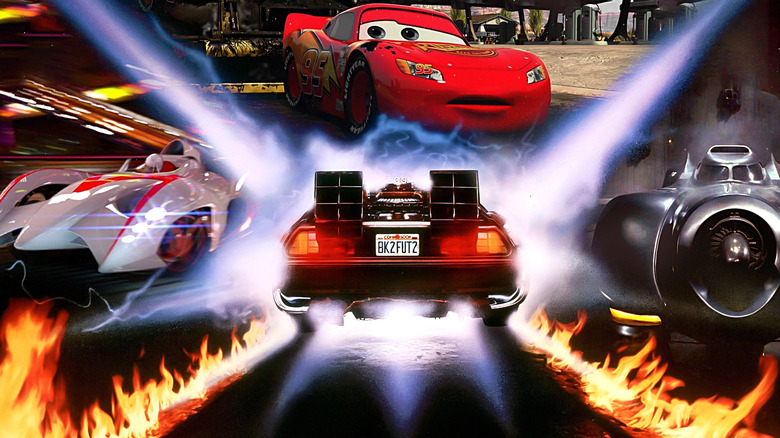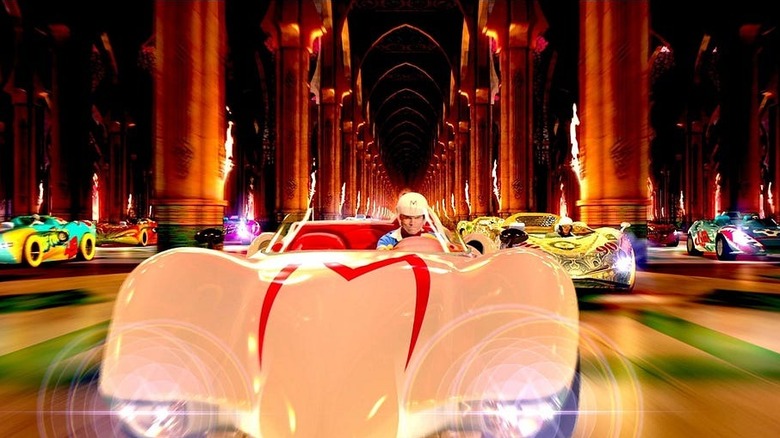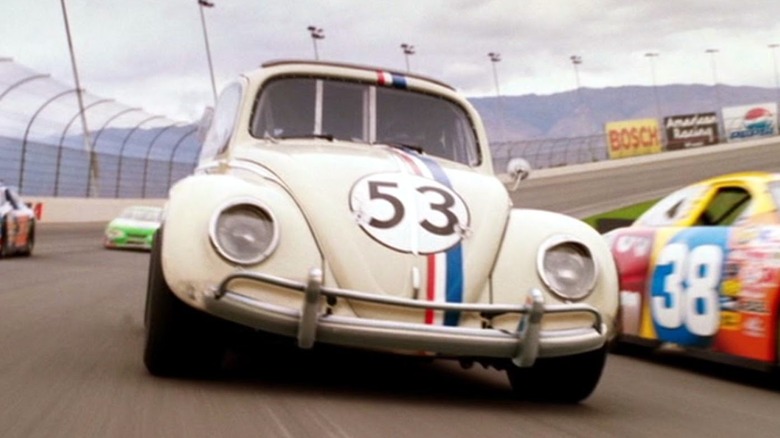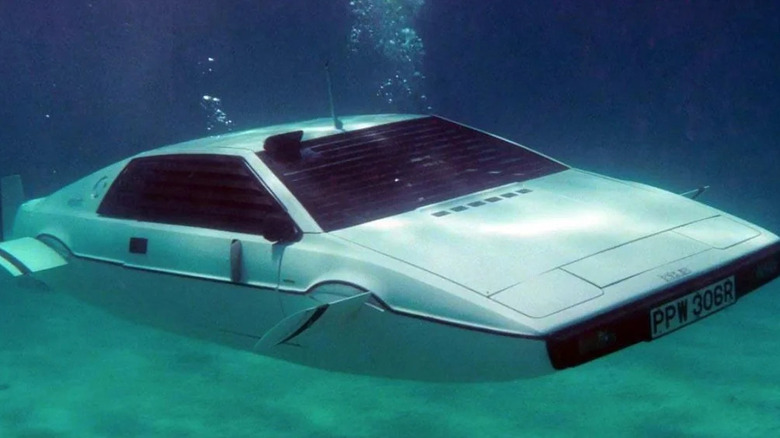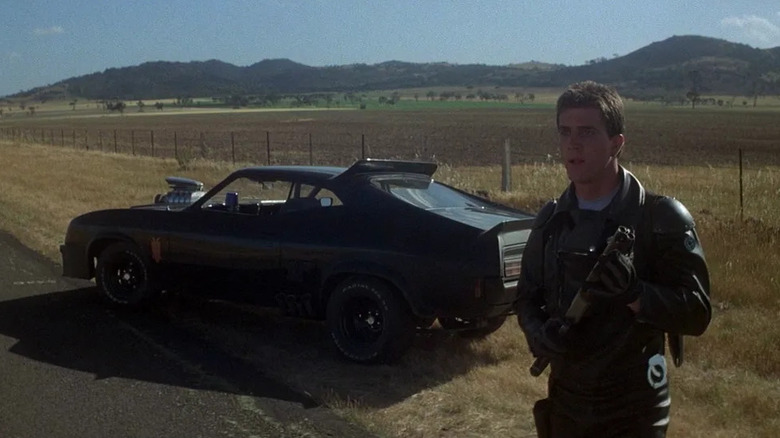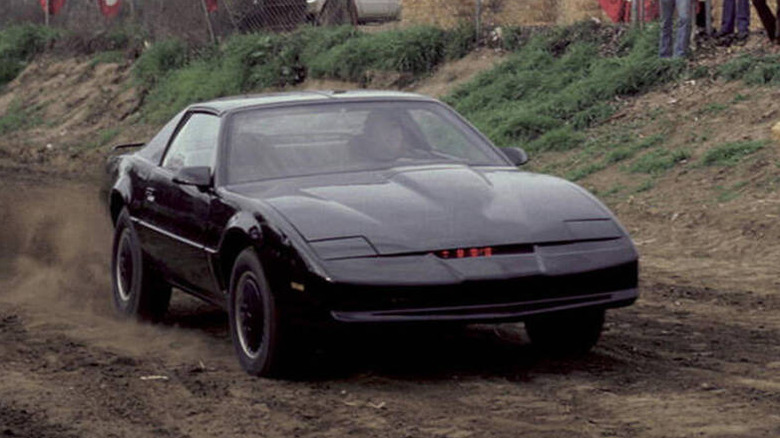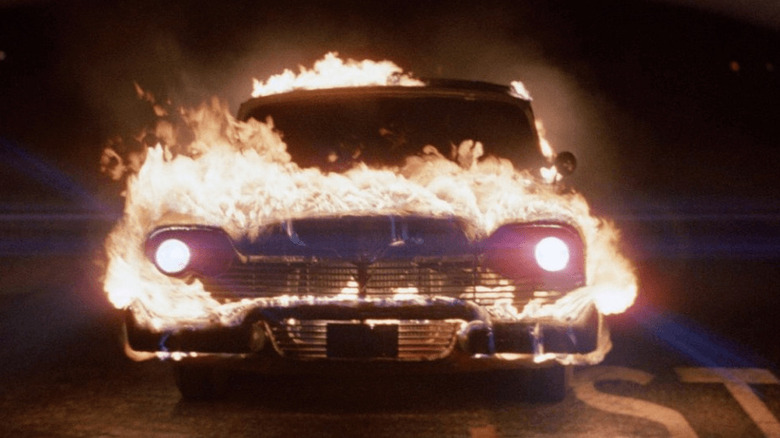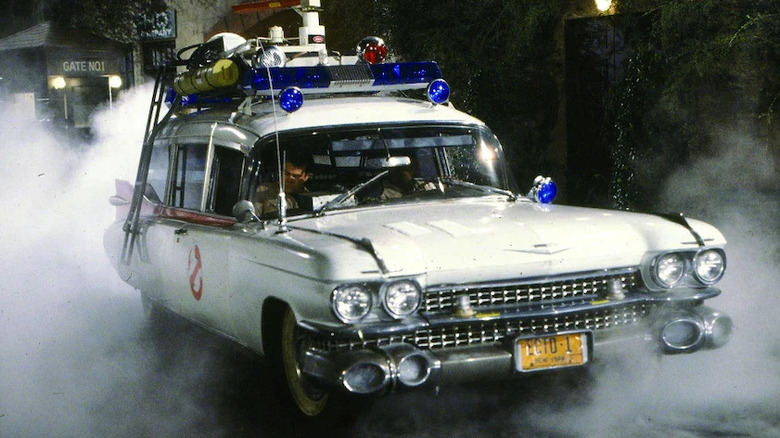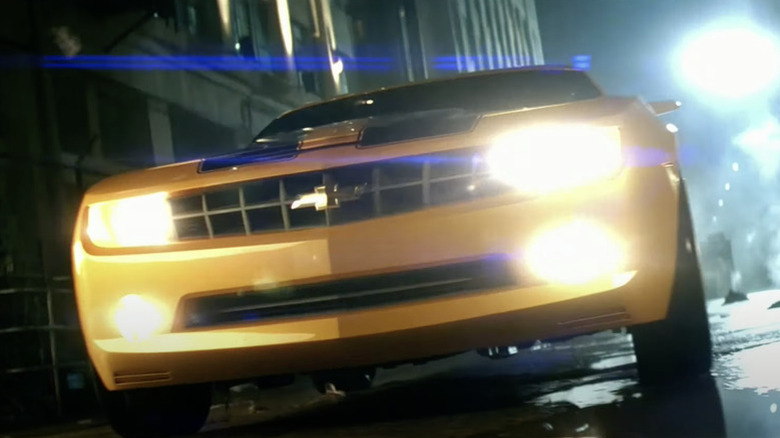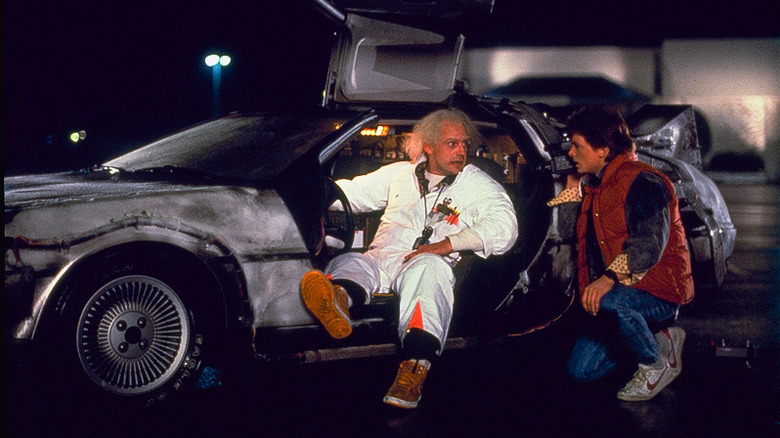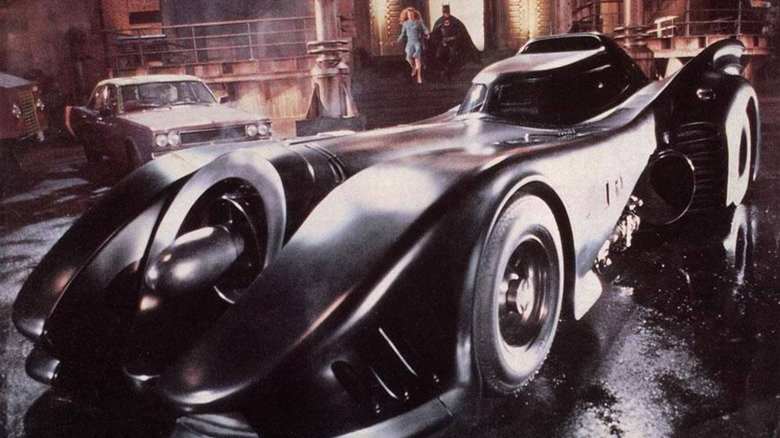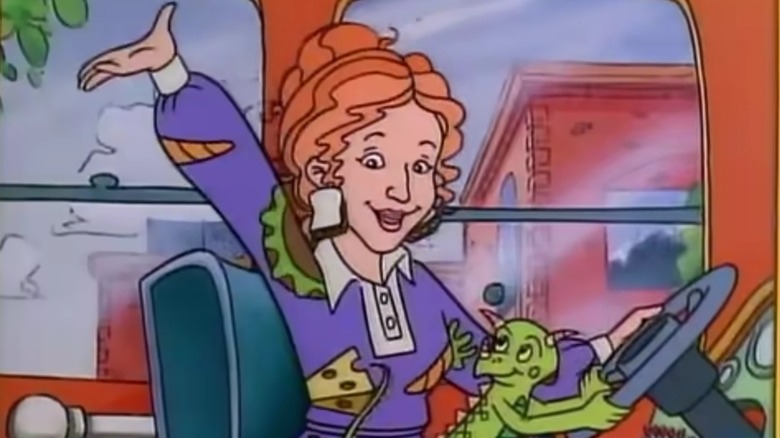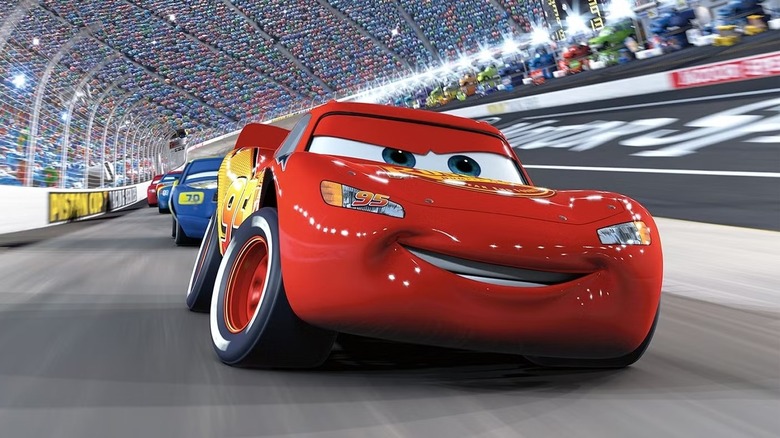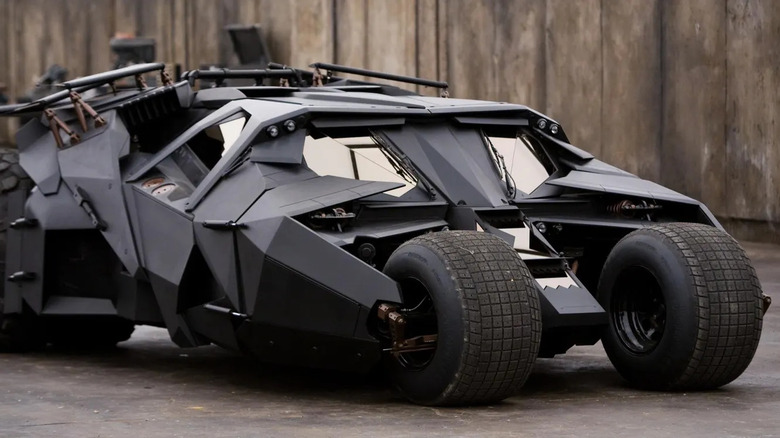The 15 Best Fictional Cars In Movies & TV Shows
Every cool movie character deserves an equally memorable set of wheels and there are plenty of movie cars that race past audience expectations. While vehicles like Bullitt's Ford Mustang or the rides in the "Fast & Furious" series fit the bill, there is about unattainable fictional cars that put them on another level. In some cases, these fictional cars are characters themselves, displaying a clear sentience to help or hinder the humans. Often impressive technical feats, the best of these cars come to embody their franchises and steal the show whenever they're on-screen.
To be clear, for the purposes of this list, a fictional car is something that has received enough alterations to set them apart from any mass-market counterparts. Several of these cars are modified versions of existing automobiles available to the public, but either fitted with extensive after-market changes or displaying story-driven features. Here are the 15 best fictional cars in movies and TV shows to check out.
James Bond's Aston Martin DB5 (Goldfinger)
Any gadget-laden sports and luxury car, particularly within the spy genre, owes a debt of influence to James Bond's Aston Martin DB5. It wouldn't be until the franchise's third entry that the Aston Martin DB5 debuted in 1964's Goldfinger, replacing Bond's usual Bentley. Since then, Bond became inextricably linked to Aston Martin, even as the franchise took on different automotive corporate sponsors that temporarily saw him drive various alternatives. Even within that association, Bond drove different models of Aston Martins over the years, but none have surpassed the legacy of the DB5.
Though Bond had used gadgets before "Goldfinger," the Aston Martin DB5 made Bond's MI6-issued rides stylish combat vehicles moving forward. The DB5 had front-mounted machine guns, a homing device tracker, rear-mounted cannons and a smokescreen emitter, and, of course, a front passenger ejector seat. The car would reappear in 1965's "Thunderball," as well as memorably resurfacing during the subsequent Pierce Brosnan and Daniel Craig eras as Bond. A car that almost never existed, the Aston Martin DB5 blended Bond's sense of opulent style with light sci-fi cool.
Dragula (The Munsters)
Also known as the DRAG-U-LA, the Dragula was one of the custom cars designed for the '60s television series "The Munsters." While the Munsters Koach was the main family car, the Dragula was the fastest, designed by the family's vampiric grandfather, Count Sam Dracula (Al Lewis). Refashioned from an old coffin, the Dragula was primarily a drag racing vehicle created by Grandpa to win back the Munsters Koach from a local racer. A different version of the Dragula was built by Grandpa for Herman Munster (Fred Gwynne) to use for a cross-country race in the 1966 spin-off movie "Munster, Go Home!"
A car so memorable that Rob Zombie wrote an entire hit single all about it, the Dragula's legacy has exceeded that of the Munsters Koach. The car keeps the ghoulish appeal that "The Munsters" was known for, while giving the series its own high-speed ride. "The Munsters" are so beloved because it's a subversive take on family sitcoms that fully embraces the horror-themed macabre. Many of those sensibilities are embodied by the Dragula, effortlessly blending sitcom tropes with campy horror possibilities to create something uniquely cool.
Mach Five (Speed Racer)
The most famous racing manga and anime in the world is "Speed Racer," created by Tatsuo Yoshida, who went on to produce the original anime series premiering in 1967. Even as early as the '60s anime adaptation, the Mach Five was fitted with gadgets to handle the perils of the road. These upgrades include built-in springs to have the car leap over obstacles, a bulletproof cockpit, submersible capabilities, and giant front-mounted blades to cut through road hazards. The Mach Five is a one-of-a-kind race car built by Pops Racer, the genius father of protagonist Speed Racer.
The Mach Five is the most recognizable anime car and has been retained in every version of Yoshida's classic story, including the 2008 Hollywood adaptation of the anime. With its bright white finish, stylized red "M" on its hood, and pointed front, the car definitely stands out from its competitors. The addition of the Mach Five's gadgets propels "Speed Racer" into a more fantastical high-octane world where professional racing comes with a surprising amount of deadly intrigue. With a titular protagonist literally named Speed Racer, you expect a fast and cool car to come with the premise, with the Mach Five delivering.
Herbie (The Love Bug)
While Volkswagen Beetles had been in production for decades prior, it came to symbolize hip mod culture in the '60s. The car's cozy appeal was highlighted in the 1968 Disney movie "The Love Bug," which introduced the sentient Beetle, Herbie. The movie has disillusioned racer Jim Douglas (Dean Jones) rescue Herbie from an abusive car dealer, befriending it as he returns to the racing scene. The movie's success led to three direct sequels and revival movies in the '90s and 2000s, all centered around Herbie and his various drivers.
With Herbie, the distinguishing features and charm inherent to the car isn't in any extras installed into the Beetle. Instead, this is a fictional car whose likability is primarily derived from his personality, a diminutive underdog compared to his racing rivals. Herbie also often finds himself falling into an unlikely matchmaker role, pushing his driver to find romance between races. A small car with a lot of personality, Herbie provided plenty of family-friendly racing stories with classic stakes with a light fantasy premise.
James Bond's Lotus Esprit S1 (The Spy Who Loved Me)
If there was ever a car driven by James Bond to stand next to the legacy of the Aston Martin DB5, it's the Lotus Esprit S1. With Bond actor Roger Moore behind the wheel, the Lotus was introduced in 1977's "The Spy Who Loved Me" as his latest gadget-armed ride. Used in a high-octane car chase across Sardinia, Bond is pursued by a variety of enemy vehicles and aircraft. As the chase seemingly reaches its climax, Bond drives the Lotus straight into the ocean where it's revealed to be a fully functional submarine.
The Lotus Esprit is arguably the most outlandishly cool car Bond has driven yet, a '70s alternative to the timeless style of the Aston Martin. That the car has a full set of gadgets and weapons for both land and underwater makes it incredibly versatile and well-armed. Moore's Bond would drive a Lotus in one additional movie, 1981's "For Your Eyes Only," but the car's impact on the franchise was already acutely felt. Easily one of the best James Bond cars, the Lotus Esprit S1 feels like the definitive automotive special effect.
V8 Interceptor (Mad Max)
In the dystopian future of the "Mad Max" franchise, the most impressive line of cars is the Pursuit Special, with protagonist Max Rockatansky driving his own custom model. Dubbed the V8 Interceptor, Max's Pursuit Special is, in actuality, a heavily modified Ford Falcon made by the original 1979 movie's production team. In-universe, Max receives the Interceptor from the Main Force Patrol, a law enforcement organization he works for at the beginning of the first movie. By 1981's "Mad Max 2," the Interceptor is reputedly the last car of its kind, with Max rebuilding it every time that it's destroyed.
Fitted with a prominent supercharger protruding from its front hood, along with additional exhaust pipes to handle the higher output, the Interceptor cuts a mean figure on the road. After the off-screen nuclear armageddon between the first two movies, Max modifies the Interceptor, including adding larger fuel canisters. To create the Interceptor, the "Mad Max" crew built a real rocket car, with all the expected real-life dangers in the task. A car instrumental in surviving the apocalypse, the Interceptor keeps Max one step ahead of death.
KITT (Knight Rider)
From its pulsating electronic theme song to the presence of peak David Hasselhoff, the original "Knight Rider" series exuded '80s cool. But as much charisma as Hasselhoff and his leather jacket brought to the show as protagonist Michael Knight, the real star was KITT. Standing for Knight Industries Two Thousand, KITT was the artificial intelligence program for Knight's futuristic car, voiced by William Daniels. An upgraded 1982 Pontiac Trans Am, KITT was essentially a mobile supercomputer to help Knight fight crime. Knight occasionally deployed KITT from a mobile garage, while the car was fully capable of driving itself, communicating with Knight through his wristwatch.
With everything from a bulletproof exterior and deployable parachute to a laser cannon and stun gas emitters, the amount of gadgets installed in KITT is lovably ridiculous. More than just a flashy car with its own literal personality, KITT had more upgrades than even a typical Bond car. While "Knight Rider" was revived and rebooted over the years, the original KITT is still the coolest car in the franchise. The ultimate in '80s swagger, KITT remains arguably the coolest fictional car to ever grace television screens.
Christine (Christine)
Stephen King's killer car novel "Christine" was adapted by horror legend John Carpenter in 1983, released eight months after the book. The story follows misfit high schooler Arnie Cunningham (Keith Gordon) who buys a dilapidated 1958 Plymouth Fury, nicknamed Christine, unaware of the dark history behind the car. As Arnie's best friend Dennis (John Stockwell) learns about the line of deaths surrounding Christine, Arnie's personality is corrupted by the car. Christine begins displaying malevolent sentience and the ability to supernaturally self-repair as it claims a fresh set of victims.
Though both John Carpenter and Stephen King have dismissed the film adaptation of "Christine" in the years following its release, it's an underrated '80s horror movie. A lot of that appeal comes from the slow burn reveal of Christine's lethal nature and paranormal abilities as the movie progresses. The movie elevates the classic muscle car at its core with its use of '50s rockabilly and blues songs to set the haunting mood. An overlooked entry in Carpenter's filmography, "Christine" is a slasher movie with a car as killer that all somehow works.
Ecto-1 (Ghostbusters)
Whether it's the Bluesmobile in "The Blues Brothers" or the Ecto-1 in "Ghostbusters," Dan Aykroyd drove some of the most iconic '80s movie cars. But while the Bluesmobile was just a slightly modified Dodge Monaco, the Ecto-1 was a full-on sci-fi marvel that only doubled down on its incredible upgrades as the franchise progressed. Introduced in 1984's "Ghostbusters," the Ecto-1 is a converted Cadillac Miller-Meteor Sentinel with an ambulance-style endloader. Even in its first appearance, the Ecto-1 had gadgets visibly installed but it wouldn't be until the subsequent animated series and revival movies that its full capabilities would be explored.
Initially, the only gadgets seen in use on the Ecto-1 were custom racks from the Ghostbusters' gear, including their iconic proton packs. By "The Real Ghostbusters," the Ecto-1 had been upgraded considerably, fitted with its own large proton cannon on occasion. "Ghostbusters: Afterlife" and "Ghostbusters: Frozen Empire" continue this trend, with deployable swivel seats, a drone bay, and even a ghost trap on top of the car itself. The signature car for the "Ghostbusters" in film and animated television, even the Ecto-1 toy looks incredible, if you're willing to shell out for it.
Bumblebee (Transformers)
The Transformers world, of course, is full of sentient robots from the planet Cybertron who can take on the forms of vehicles and animals. While perennial protagonist Optimus Prime often transforms into a big rig truck and usual antagonist Starscream usually turns into a fighter jet, Bumblebee often assumes a more domestic vehicle form. Initially transforming into a Volkswagen Beetle, Bumblebee received a significantly cooler upgrade in the 2007 live-action movie "Transformers." Director Michael Bay tracked down the perfect car for Bumblebee, making his alternate form a Chevrolet Camaro for the film series.
While the original Beetle association with Bumblebee will always have a nostalgic fondness, the Camaro change was a welcome one. The 2018 movie "Bumblebee" provided a surprise balance between the two, with the heroic Transformer taking on both car forms during the story. Bumblebee has always maintained a link between humanity and Transformers, and his automotive evolution reflects changing sensibilities. The unsung hero among the Autobots, Bumblebee might not bring the same vehicular muscle as his counterparts but still stands as a cool car in the ensemble.
Doc Brown's DMC DeLorean (Back to the Future)
The DMC DeLorean may have only been manufactured in the United States from 1981 to 1983, but the car's mark on cinematic history is timeless. A modified version of the car serves as the time machine developed by Doc Brown (Christopher Lloyd) in the "Back to the Future" trilogy. Powered by plutonium or 1.21 gigawatts of electricity, the DeLorean can travel to an exact time when it reaches speeds of 88 miles-per-hour. After traveling to the future of 2015, Brown has the car upgraded to be able to fly and fueled by common garbage through cold fusion.
Originally, the original time machine planned for "Back to the Future" wasn't anywhere near as stylish as a DeLorean. Since its inclusion in the hit 1985 movie and its sequels, the DeLorean has become one of the most beloved cinematic cars of all time. The DeLorean has captivated audiences so much that it has served as the subject of multiple documentaries chronicling its legacy. "Back to the Future" took what could've been a footnote in automotive history and turned it into the centerpiece of one of the most enduring sci-fi movies.
Batmobile (Batman)
The most iconic superhero ride, the Batmobile has been a staple in the Batman mythos since it was adapted into movie serials in the '40s. While the '60s Batmobile driven by Adam West certainly has a fond place in our hearts, the coolest one of them all is the one driven by Michael Keaton. Debuting in 1989's "Batman" directed by Tim Burton, the Keaton era Batmobile is a sleek, armored vehicle with built-in guns and missiles and a jet engine to power forward. "Batman Returns" gave the Batmobile even more gadgets, including the ability for the Bat-Cycle to be ejected from its cockpit.
In a lot of ways, Keaton's Batmobile remains the most iconic iteration of the car, certainly over the neon-lit versions appearing in the movies directed by Joel Schumacher. With its appearances elevated by Danny Elfman's operatic score, this Batmobile fits Burton's darker take on the Caped Crusader. Moreover, the 1989 Batmobile design is just undeniably cool, standing as a virtually unstoppable force against evil in Gotham City. Setting the template for Batmobiles to follow, the 1989 version of the car is a standout for the superhero genre.
Magic School Bus (The Magic School Bus)
Anyone who went to American elementary schools in the '90s is probably familiar with the "Magic School Bus" educational book series by Joanna Cole and Bruce Degen. The books were adapted into a popular animated series in 1994, with Lily Tomlin voicing eccentric schoolteacher Valerie Frizzle. Ms. Frizzle leads her small elementary class on fantastical field trips made possible by the titular school bus. Among its awesome features, the bus is capable of shrinking down and exploring the human body or blasting off to the edge of the solar system.
As immersive as the panoramic books it was based off of, "The Magic School Bus" thrilled young audiences for years. The bus' origins and full capabilities are never quite revealed, but kickstarted the imaginations of viewers and readers nonetheless. Part time machine, part spaceship, and more, the bus was the ultimate impossible vehicle making its various lessons possible. A fun font of basic science education, "The Magic School Bus" remains a nostalgic favorite for all who grew up with it.
Lightning McQueen (Cars)
For a movie all about sentient cars, there are plenty of memorable automotive characters throughout Pixar's popular "Cars" franchise. At the end of the day, though, the crown really has to go to series' perpetual protagonist Lightning McQueen. Voiced by Owen Wilson, McQueen is an anthropomorphic stock car who longs to win the prestigious Piston Cup. A bona fide racing legend by the end of the "Cars" trilogy, McQueen blends his innate racing skills and old-school methods taught by his mentor Doc Hudson (Paul Newman) to win.
Lightning McQueen is a character that learns humility and the merits of sportsmanship -– well, sportscarship -– over the course of the franchise. By "Cars 2," McQueen took his skills to the global stage, participating in a multi-country grand prix spanning from Tokyo to London. The level of McQueen's unwavering spirit is explored in the surprisingly emotional "Cars 3," with the racer returning to the track after enduring a harrowing accident. The face of one of Pixar's most prolific franchises, Lightning McQueen brings classic sports tropes to a strange world full of living cars.
The Tumbler
While it may feel like cheating to have two iterations of the Batmobile on this list, the Tumbler is so radically different from its counterparts, it earns a spot here. Introduced in 2005's "Batman Begins," the Tumbler was inspired by a shameless studio note to filmmaker Christopher Nolan. The Tumbler is effectively a small tank, armored, fitted with a large engine for short jumps, mounted guns and missiles, and capable of stealth mode. 2008's "The Dark Knight" reveals that Tumbler can eject the Bat-Pod, basically this trilogy's version of the Bat-Cycle, when damaged.
Nolan almost didn't put the Batmobile in "Batman Begins," but the Tumbler came to embody his more grounded approach to the superhero franchise. Nominally practical, the car even gets its own backstory, with the prototype described as being designed as a way to deploy makeshift bridges during the Gulf War. The Tumbler's inclusion gives "Batman Begins" and "The Dark Knight" some of the best action set pieces in the entire trilogy. The Tumbler signaled that Christian Bale's Batman would be unlike any other that came before him, combining real-world aesthetics without compromising on style.
